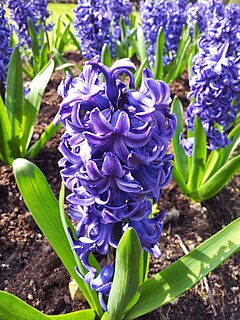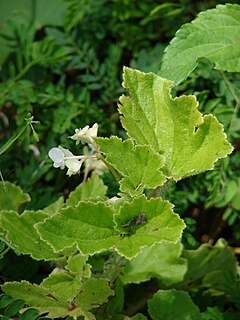
Equidae is the taxonomic family of horses and related animals, including the extant horses, donkeys, and zebras, and many other species known only from fossils. All extant species are in the genus Equus. Equidae belongs to the order Perissodactyla, which includes the extant tapirs and rhinoceros, and several extinct families.
A genus is a taxonomic rank used in the biological classification of living and fossil organisms, as well as viruses, in biology. In the hierarchy of biological classification, genus comes above species and below family. In binomial nomenclature, the genus name forms the first part of the binomial species name for each species within the genus.

Binomial nomenclature, also called binominal nomenclature or binary nomenclature, is a formal system of naming species of living things by giving each a name composed of two parts, both of which use Latin grammatical forms, although they can be based on words from other languages. Such a name is called a binomial name, a binomen, binominal name or a scientific name; more informally it is also called a Latin name.

Begonia is a genus of perennial flowering plants in the family Begoniaceae. The genus contains more than 1,800 different plant species. The Begonias are native to moist subtropical and tropical climates. Some species are commonly grown indoors as ornamental houseplants in cooler climates. In cooler climates some species are cultivated outside in summertime for their bright colorful flowers, which have sepals but no petals.
Family is one of the eight major hierarchical taxonomic ranks in Linnaean taxonomy; it is classified between order and genus. A family may be divided into subfamilies, which are intermediate ranks between the ranks of family and genus. The official family names are Latin in origin; however, popular names are often used: for example, walnut trees and hickory trees belong to the family Juglandaceae, but that family is commonly referred to as being the "walnut family".
In biological classification, the order is
- a taxonomic rank used in the classification of organisms and recognized by the nomenclature codes. Other well-known ranks are life, domain, kingdom, phylum, class, family, genus, and species, with order fitting in between class and family. An immediately higher rank, superorder, may be added directly above order, while suborder would be a lower rank.
- a taxonomic unit, a taxon, in that rank. In that case the plural is orders.

Euphorbia is a very large and diverse genus of flowering plants, commonly called spurge, in the spurge family (Euphorbiaceae). "Euphorbia" is sometimes used in ordinary English to collectively refer to all members of Euphorbiaceae, not just to members of the genus. Some euphorbias are commercially widely available, such as poinsettias at Christmas. Some are commonly cultivated as ornamentals, or collected and highly valued for the aesthetic appearance of their unique floral structures, such as the crown of thorns plant. Euphorbias from the deserts of Southern Africa and Madagascar have evolved physical characteristics and forms similar to cacti of North and South America, so they are often incorrectly referred to as cacti. Some are used as ornamentals in landscaping, because of beautiful or striking overall forms, and drought and heat tolerance.

Fagaceae is a family of flowering plants that includes beeches and oaks, and comprises eight genera with about 927 species. The Fagaceae are deciduous or evergreen trees and shrubs, characterized by alternate simple leaves with pinnate venation, unisexual flowers in the form of catkins, and fruit in the form of cup-like (cupule) nuts. Their leaves are often lobed and both petioles and stipules are generally present. Leaf characteristics of Fagaceae can be very similar to those of Rosaceae and other rose motif families. Their fruits lack endosperm and lie in a scaly or spiny husk that may or may not enclose the entire nut, which may consist of one to seven seeds. In the oaks, genus Quercus, the fruit is a non-valved nut called an acorn. The husk of the acorn in most oaks only forms a cup in which the nut sits. Other members of the family have fully enclosed nuts. Fagaceae is one of the most ecologically important woody plant families in the Northern Hemisphere, as oaks form the backbone of temperate forest in North America, Europe, and Asia and one of the most significant sources of wildlife fodder.

The Rutaceae are a family, commonly known as the rue or citrus family, of flowering plants, usually placed in the order Sapindales.

Pitcher plants are several different carnivorous plants which have modified leaves known as pitfall traps—a prey-trapping mechanism featuring a deep cavity filled with digestive liquid. The traps of what are considered to be "true" pitcher plants are formed by specialized leaves. The plants attract and drown their prey with nectar.

The thrushes are a passerine bird family, Turdidae, with a worldwide distribution. The family was once much larger before biologists determined the subfamily Saxicolinae, which includes the chats and European robins, were Old World flycatchers. Thrushes are small to medium-sized ground living birds that feed on insects, other invertebrates and fruit. Some unrelated species around the world have been named after thrushes due to their similarity to birds in this family.

A raceme or racemoid is an unbranched, indeterminate type of inflorescence bearing pedicellate flowers along its axis. In botany, an axis means a shoot, in this case one bearing the flowers. In indeterminate inflorescence-like racemes, the oldest flowers are borne towards the base and new flowers are produced as the shoot grows, with no predetermined growth limit. A plant that flowers on a showy raceme may have this reflected in its scientific name, e.g. Cimicifuga racemosa. A compound raceme, also called a panicle, has a branching main axis. Examples of racemes occur on mustard and radish plants.

Hyacinthus is a small genus of bulbous, spring-blooming perennial, fragrant flowering plants in the family Asparagaceae, subfamily Scilloideae. These are commonly called hyacinths. The genus is native to the eastern Mediterranean.
In biology, a monotypic taxon is a taxonomic group (taxon) that contains only one immediately subordinate taxon.

In zoological nomenclature, a type species is the species name with which the name of a genus or subgenus is considered to be permanently taxonomically associated, i.e., the species that contains the biological type specimen(s). A similar concept is used for suprageneric groups and called a type genus.

Anthurium, is a genus of about 1000 species of flowering plants, the largest genus of the arum family, Araceae. General common names include anthurium, tailflower, flamingo flower, and laceleaf.

A botanical name is a formal scientific name conforming to the International Code of Nomenclature for algae, fungi, and plants (ICN) and, if it concerns a plant cultigen, the additional cultivar or Group epithets must conform to the International Code of Nomenclature for Cultivated Plants (ICNCP). The code of nomenclature covers "all organisms traditionally treated as algae, fungi, or plants, whether fossil or non-fossil, including blue-green algae (Cyanobacteria), chytrids, oomycetes, slime moulds and photosynthetic protists with their taxonomically related non-photosynthetic groups ."

Begoniaceae is a family of flowering plants with two genera and about 1825 species occurring in the subtropics and tropics of both the New World and Old World. All but one of the species are in the genus Begonia. The only other genus in the family, Hillebrandia, is endemic to the Hawaiian Islands and has a single species. Phylogenetic work supports Hillebrandia as the sister taxon to the rest of the family. The genus Symbegonia was reduced to a section of Begonia in 2003, as molecular phylogenies had shown it to be derived from within that genus. Members of the genus Begonia are well-known and popular houseplants.

In biological classification, taxonomic rank is the relative level of a group of organisms in a taxonomic hierarchy. Examples of taxonomic ranks are species, genus, family, order, class, phylum, kingdom, domain, etc.

The Solanaceae, or nightshades, are a family of flowering plants that ranges from annual and perennial herbs to vines, lianas, epiphytes, shrubs, and trees, and includes a number of agricultural crops, medicinal plants, spices, weeds, and ornamentals. Many members of the family contain potent alkaloids, and some are highly toxic, but many—including tomatoes, potatoes, eggplant, bell and chili peppers—are used as food. The family belongs to the order Solanales, in the asterid group and class Magnoliopsida (dicotyledons). The Solanaceae consists of about 98 genera and some 2,700 species, with a great diversity of habitats, morphology and ecology.















